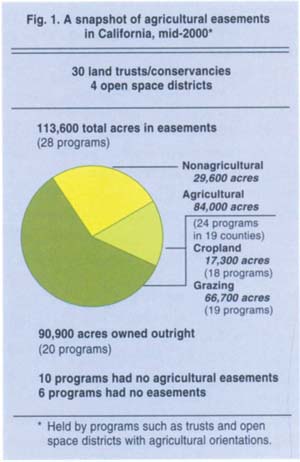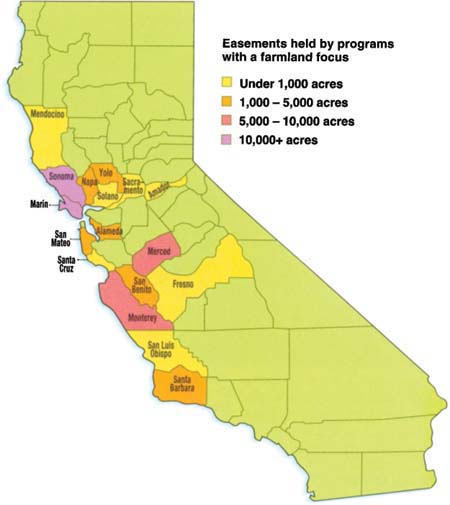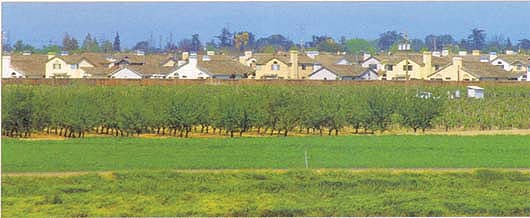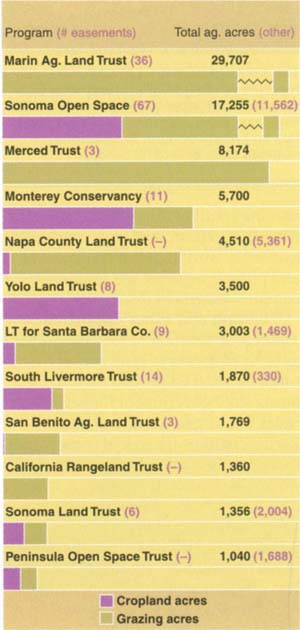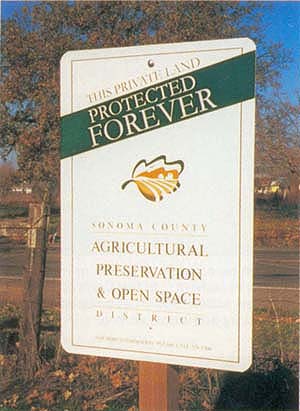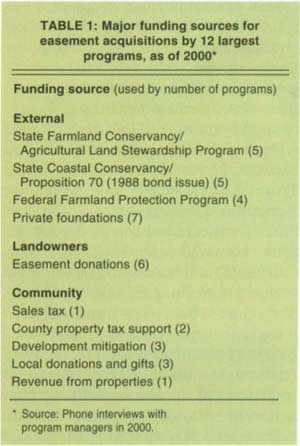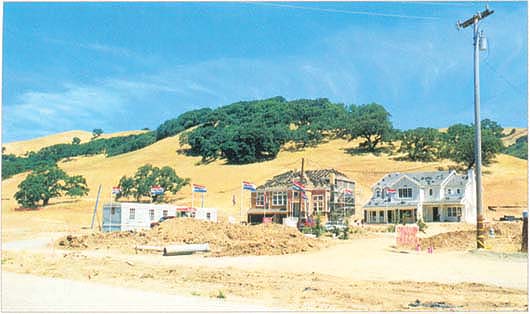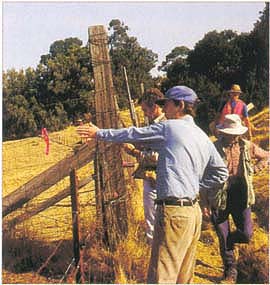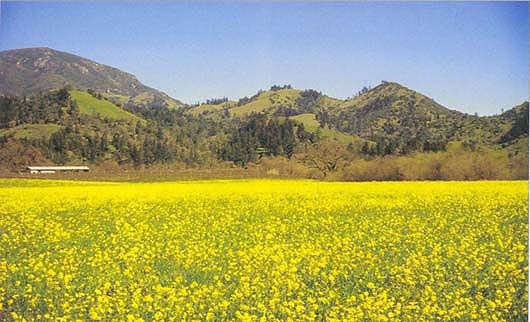All Issues
Agricultural easements limited geographically
Publication Information
California Agriculture 56(1):15-20. https://doi.org/10.3733/ca.v056n01p15
Published January 01, 2002
PDF | Citation | Permissions
Abstract
A review of conservation programs in the state shows that agricultural easements are concentrated in central coastal counties. Many of these counties, such as Marin and Sonoma, are not top agricultural regions, while some of the state's most productive agricultural counties have no easement programs at all. To date, there are approximately 120,000 California farmland acres in easements, nearly 80% of them grazing land and the rest in crops. Our review shows that state coastal conservation programs and sentiments among local populations are major reasons why easements are plentiful in some counties and not in others.
Full text
About one-third of the state's land trusts and open space districts that focus primarily on protecting farmland hold 90% of the agricultural easement acreage in California. Most acreage is concentrated on the coast and in the Bay Area. In Sonoma County, the Santa Rosa Plain can be seen from Taylor Mountain.
Just a few local and regional conservation programs have secured the vast majority of farmland acres covered by agricultural easements in California. Among the 34 land trusts and districts identified by our research as having significant farmland protection objectives, 12 held about 90% of all acres under agricultural easements throughout the state as of mid-2000.
Why are some farmland protection programs more successful than others in easement acquisitions? And what do these findings suggest for the future of easements as a farmland protection technique in California? After reviewing statewide patterns and the achievements of the most active programs, we examine the revenue and organization and other factors involved in the development of a successful agricultural easement acquisition program.
Statewide easement patterns
Agricultural easements are a compensatory and nonregulatory technique for protecting farmland from urbanization, through the purchase of development rights (or their donation) from landowners. Local conservation organizations, land trusts or public agencies acquire and hold the easements and manage them over time (American Farmland Trust 1997; Daniels and Bowers 1997).
Based on information provided by 34 identified programs with farmland protection objectives (see table 1, p. 10 ), we estimate that California now has about 120,000 acres in agricultural easements. This projection updates an earlier estimate of about 84,000 acres statewide in mid-2000, based on individual reports from program managers at that time (see fig. 1). The exact number is a moving target, since the most active programs have been picking up easements at a rapid pace. Even as program managers provided the data on easements completed in mid-2000, they also reported in-the-works transactions with landowners to acquire another 21,000 acres.
Not included in these estimates were other agricultural acres protected by easements primarily for environmental purposes, such as wetlands, habitat and riparian corridors (see p. 9 ). Anecdotal evidence suggests that there are many thousands of such acres throughout the state, with easements acquired and held by local land trusts and open space districts, national conservation organizations such as The Nature Conservancy, and state and federal wildlife agencies (Bay Area Open Space Council 1999).
Of the 34 organizations, only 24 had acquired agricultural easements by 2000, reflecting that many new programs are still in the formative stage. The programs studied held 29,600 acres in nonagricultural easements and owned outright another 90,900 acres in natural resources and recreational areas, indicating that many programs pursue multiple conservation goals.
Only about one-fifth (20.6%) of the total agricultural easement acres were cropland; four-fifths (79.4%) were grazing land. By comparison, cropland and grazing acres represent much larger and smaller shares, respectively, of California's total farmland base — about one-third and two-thirds of the total (DOC 2000). One explanation for the prevalence of grazing acres in easement programs is the relatively large size of cattle ranches and the preference of some programs to put an easement on one large ranch in a single transaction, rather than undertaking the more difficult task of seeking multiple easements from numerous owners of smaller cropland farms.
Fig. 2. Easement acres on California farmland by county, as of mid-2000. Includes about 82,000 acres in 17 counties (easements held by 18 land trusts and three open space districts). Does not include 1,800 acres in two other counties held by two trusts operating in multiple counties.
Farms under easement are an infinitesimal share of California's total 27 million agricultural acres. These are located in only 19 of the state's 58 counties (fig. 2). They are concentrated in eight coastal counties from Mendocino to the north and Santa Barbara to the south, and in three adjacent Bay Area counties (Napa, Solano and Alameda). The coastal counties alone contain more than 80% of all easement acres. Three Central Valley counties (Yolo, Sacramento and Fresno) are also represented in the easement ranks.
This geographical pattern is also notable for the regions that lacked any agricultural easement activity in 2000: the southern and northern thirds of the state. Just as striking is the absence of many important agricultural counties. Among the 11 counties that lead the state in agricultural production value, each with at least $1 billion in market receipts in 1999, only three (Fresno, Monterey and Merced) contained agricultural easements as of mid-2000 (CDFA 2000). Counties with farm market values of $1 billion or more in 1999 that did not have agriculture easements were Imperial, Kern, Riverside, San Diego, San Joaquin, Stanislaus, Tulare and Ventura. On the other hand, Sonoma and Marin — the top counties in agricultural easement acres — ranked 16th and 44th, respectively, in farm market value among all California counties.
The pattern of varying easement activity among top agricultural counties can be explained, in part, by underlying differences in the conservation sentiments of local populations. For example, Central Coast voters have shown higher levels of support for environmental measures on statewide ballots than voters in inland and southern counties (Sokolow 1998). As a result, citizen coalitions with land conservation or other environmental agendas are more likely to form in Central Coast communities, which may explain the relatively larger number of land trusts in these areas.
Yet not all Central Coast counties have active agricultural easement programs. Santa Cruz, Santa Clara and Ventura counties, for example, had recorded no agricultural easements or far fewer than nearby areas as of mid-2000. In interviews, conservation organization managers cited as reasons the higher costs of acquiring easements on farmland in some of these locations and the greater interest of local land trusts in conserving environmental lands and engaging in educational and other activities.
The largest programs
Each of a dozen programs — 11 land trusts and one open space district — had acquired easements on 1,000 or more agricultural acres as of 2000. Their collective holdings totaled about 79,000 acres, 94% of the state total.
Among the 12 programs are six coastal programs, three in adjacent counties, two in the Central Valley and one statewide program (California Rangeland Trust) (fig. 3). The two largest programs combined held more than 46,000 farmland easement acres, or slightly more than half of the statewide total. Serving adjacent North Bay counties, Marin Agricultural Land Trust (MALT) and the Sonoma County Agricultural Preservation and Open Space District have been the two most active farmland easement programs in California (and among the most active in the nation) since the mid-1990s. More than 150 separate transactions were represented by these easements. In some cases, the number of separate transactions is a better measure than total acres of the organization's achievements, since each transaction is the result of a complex process that includes extensive landowner negotiations.
Only three of California's 11 counties with agricultural receipts of $1 billion or more have farmland protected by agricultural conservation easements. In the Central Valley's San Joaquin County, which does not currently have an active land trust or open space district, farmland in Manteca, above, is being pressed by suburban sprawl.
Most of the 12 programs exclusively or primarily hold easements on grazing land. Only the Monterey, Yolo and South Livermore Valley land trusts are exclusively or primarily involved in acquiring and holding easements on cropland, although several others with large holdings in acres overall also have significant cropland acres. The crops grown on easement-protected land include artichokes, strawberries, vegetables and grapes in coastal counties, and field and orchard crops in the Central Valley.
Program success stories
The first agricultural easement in California was acquired by MALT in 1983. In fact, most of the easements accumulated by all agricultural programs by 2000 had been acquired only in the previous 5 or 6 years, since the early and mid-1990s. The 12 leading programs quickly established successful records. Other programs in our sample had accomplished far less or had yet to acquire their first agricultural easements, although some had placed significant amounts of nonagri-cultural land under environmental easements.
Each of the leading programs followed a unique path, but they have several underlying factors in common. The most critical element seems to have been early access to funds or other acquisition resources, in part a result of fortunate timing, location and community support. But success was also the result of the skill and persistence of program staff and community leaders in working with landowners and putting together the resources to complete easement deals.
Fig. 3. Leading agricultural easement programs in California, by acres. Programs with 1000+ acres each, ranked by agricultural acreage as of mid-2000.Note: Sonoma Open Space = Sonoma County Agricultural Preservation and Open Space District; Merced Trust = Merced County Farmland and Open Space Trust; Monterey Conservancy = Monterey County Agricultural and Historical Land Conservancy; South Livermore Trust = South Livermore Valley Agricultural Land Trust.
The open space district in Sonoma County receives funding from a countywide 0.25-cent sales tax, approved by voters in 1990. Most easement programs, however, must rely on private donors, foundations, or targeted state or federal funds.
Funding and other opportunities.
The coastal location of four programs gave them access to state conservation funds earmarked for this region. California state government for several decades has targeted the long, narrow Pacific coastline for special conservation measures, starting with the creation in 1972 of the Coastal Commission, a land-use regulatory agency. A more beneficial action for landowners was the formation in 1976, by state legislation, of the Coastal Conservancy, which was given the nonregulatory task of preserving coastal areas through landowner compensation. State appropriations began to flow to local agencies after the 1988 passage of Proposition 70. This bond issue generated $776 million for state and local land-conservation programs, mainly to acquire and improve parks and wildlife habitat. A small portion of the total, some allocated through the Coastal Conservancy, eventually was used to acquire easements on farmland that had other resource values (Coastal Conservancy 1989).
At least four of the successful programs benefited from these actions shortly after their formations. MALT, the Sonoma Land Trust (a separate nonprofit entity from the open space district) and the Monterey County Agricultural and Historical Land Conservancy, either independently or with their county governments, each received a $1 million grant from the Coastal Conservancy in the mid-1980s. All three land trusts, together with the Peninsula Open Space Trust (south of San Francisco), a few years later obtained Proposition 70 funds for easement activities.
Two land trusts among the 12 leading agricultural programs have prospered from a different type of funding stimulus — local government mitigation of farmland loss, which requires urban development projects to pay for easements on comparable farmland. The Yolo Land Trust received its initial easements as the result of a mitigation ordinance passed by the city of Davis in 1995, the first such municipal action in California. The South Livermore Valley Agricultural Land Trust was formed and acquired many of its easements as the result of litigation, in which the city of Livermore successfully challenged a large residential project. Another trust that has concentrated on environmental easements, the Solano County Farmland and Open Space Foundation, also benefits from a mitigation arrangement as a result of litigation involving the city of Fairfield.
The Sonoma County Agricultural Preservation and Open Space District is in a different funding category because of its countywide 0.25-cent sales tax, approved by voters in 1990. The district, which relies exclusively on this 20-year revenue source for its operations and purchases, was the only California entity with a dedicated tax for acquiring farmland easements until November 2000, when voters in Davis approved a parcel tax to fund a land conservation program that includes easements.
Several of the other leading programs depended largely or primarily on landowner donations of easements, including Napa County Land Trust, Land Trust for Santa Barbara County, California Rangeland Trust and Sonoma Land Trust. All four have broader open space and conservation interests than just farmland protection, and their donated easements have come primarily from owners of large ranches who are generally motivated by the tax benefits or preservation of the environmental qualities of their properties.
Beyond their formative years, most of the successful programs have been able to tap a variety of sources to fund easement acquisitions (table 1). External sources and landowner donations of easements were most frequently used, particularly grants from state and federal governments and from private foundations. Internal sources, including both private funds and public revenues, were less widely used. California's strict rules for funding local government programs, especially the restricted property tax and two-thirds voter approval requirements for new or increased taxes, severely limit the ability of communities to support easement programs with local taxes.
Entrepreneurship.
The less tangible elements of program entrepreneurship were also important to the success of the leading programs. Even with early funding opportunities, the leaders of the better-funded programs had to apply skill, focus and persistence, and to work hard over long periods of time, to get their organizations going. To build a record of acquisitions, they had to look for funds from competitive sources and/or seek landowner donations. Program leaders had to match funding with landowner interests, a process that involved a time-sensitive juggling of several inter-related factors: dealing with foundations and state government as funding sources, selecting or seeking out appropriate parcel candidates according to the trust's priorities, matching available funding with available land-owners and negotiating with land-owners.
Obstacles to more widespread use of agricultural easements include lack of local interest and limited funds. Many landowners are reluctant to relinquish the right to sell land for development some time in the future. These luxury homes are under construction in Novato, Marin County.
Each easement transaction is process unto itself. One land trust manager estimated that the average direct cost of completing a transaction was $15,000 in staff time and other expenses. Another estimated that putting an easement together required several hundred hours in staff time.
As much as funding or landowner donations, the critical resources in this process were the personal skill, focus and persistence of program leaders. The successful programs generally have small professional staffs, but they also rely extensively on the work of volunteer boards, which typically include members with expertise in law, resource management, agriculture, finance, land appraisal and other relevant areas. Land trusts with boards composed substantially of farmland owners, such as the Yolo and Merced trusts, are especially equipped to use board members' local knowledge and personal contacts in persuasive discussions with other farmers and ranchers who own desirable parcels. Explaining this strategy, one land trust manager noted: “The [founders of the trust] knew that they couldn't be an urban group going out to the farmers and telling them how to change their land. The message had to come from colleagues — other farmers and ranchers in the community…. If you want to be effective in agricultural preservation, you need to get along with the people of the land… and that includes the (local) Farm Bureau” (interview, July 7, 1999).
Obstacles to widespread use
Despite recent achievements of the leading programs and general popularity of this nonregulatory technique for preserving farmland, agricultural easement programs have not yet caught on in a substantial way in most of California's agricultural counties. The limited progress so far may be understandable, considering the still-new status of the technique as a farmland protection tool. In time, with greater familiarity and acceptance in agricultural and other community circles, and fueled by the achievements of the first active programs, there could be a rapid expansion in the number and geographical extent of programs and acres covered (Great Valley Center 1998).
This is not a certain scenario in the near future, however. There are at least three major obstacles to more widespread use of the agricultural easement technique.
Difficulty of organizing
It takes a high degree of citizen interest or local government support to form a land trust or open space district, qualities not currently present in many agricultural areas. Local and regional organizations run the easement programs, rather than more distant state government and other outside agencies, because successful easement transactions depend on close relations with landowners. Most of the land trusts in our study were created through the grassroots efforts of a few community leaders or environmental activists, organizing effectively to pursue shared conservation goals. Other land trusts and open space districts originated more directly through local government action, including voter approval.
The Weston family sold an easement on their 1,160-acre ranch north of Santa Rosa, which will be preserved for natural resources and cattle ranching.
Lack of revenue stream
Few of the established programs in California enjoy a steady revenue stream for building large agricultural easement portfolios. Programs with substantial acquisitions have relied largely on fluctuating and opportunistic revenue sources, primarily state government funds and foundation grants. They generally lack the certainty that an ongoing, dedicated local tax source could provide. As a result, most programs acquire easements in fits and starts, limiting their ability to plan and work quickly with interested landowners.
Landowner reluctance
Landowners cannot be compelled to enter into an easement transaction by government regulation or eminent domain; selling or donating an easement is entirely voluntary. This means that programs must rely on each landowner's understanding of the technique and personal estimate of benefits and costs. For many landowners, easements are a foreign or confusing concept. They offer the unwelcome prospect of having less control over their land and create uncertainties about the long-term consequences for immediate heirs and later generations of owners. Landowners located near rapidly urbanizing areas are especially reluctant to consider the easement option, as they believe that they will be able to prosper by selling their parcels for residential or commercial development sometime in the future. Finally, even with a supply of willing landowners, there is the challenge of fitting the available properties into a program's criteria for location, agricultural quality and easement price. Nonetheless, the successful programs demonstrate that a few early transactions with landowners respected in the local farm community can break the ice for subsequent deals (Rilla and Sokolow 2000).
Future of easements
Primarily because they are nonregulatory and voluntary, easements on farmland increasingly appeal to landowners and communities attempting to protect open space and agriculture. With about 120,000 farm acres covered statewide, agricultural easements have become an important farmland protection tool in California in less than two decades. A small number of local land trusts and open space districts, assisted by funding opportunities and entrepreneurship, have established successful programs.
Yet the active programs operate in only a minority of California's major agricultural counties. Many of these areas lack easement programs because of the absence of citizen interest and mobilization combined with local government inaction. Most established programs also are limited in their easement acquisitions, largely because of unsteady revenues, limited entrepreneurship and reluctant landowners.
Undoubtedly, the few successful programs will continue to grow and expand their easement holdings. But expanding agricultural easements to major agricultural regions is the key to making optimal use of the technique in California.




